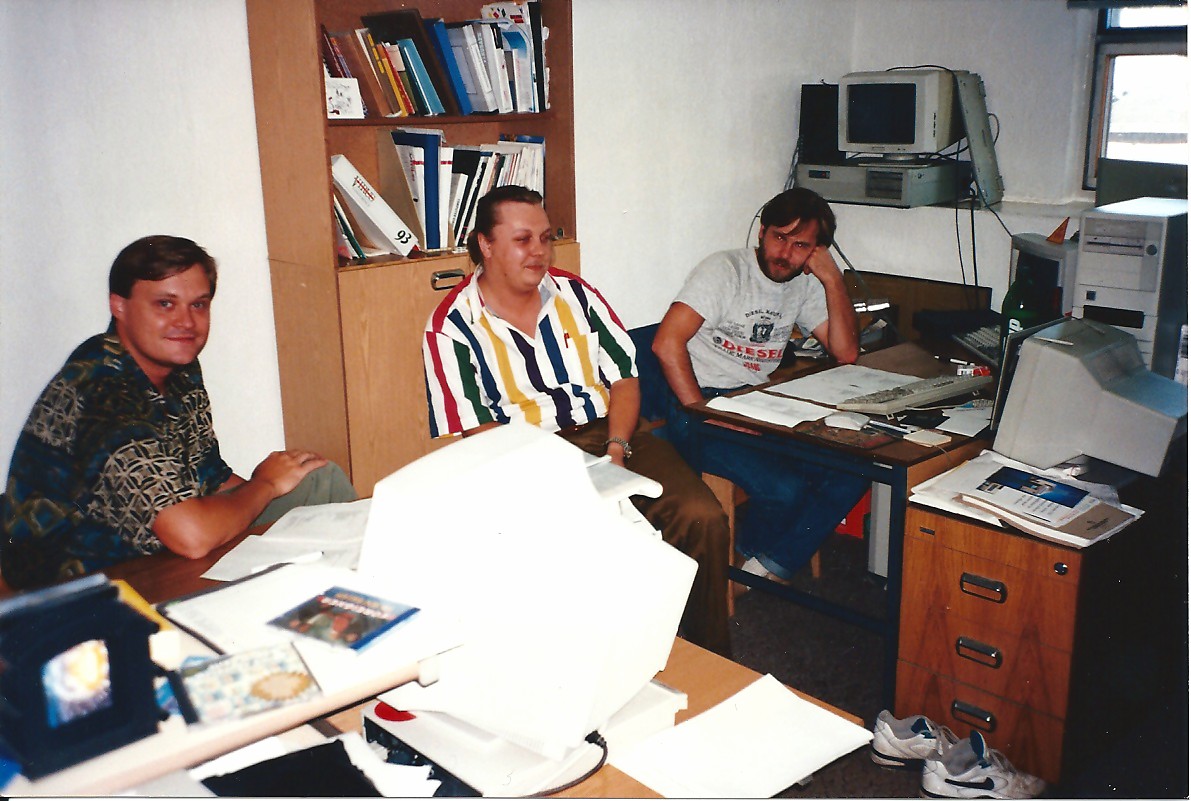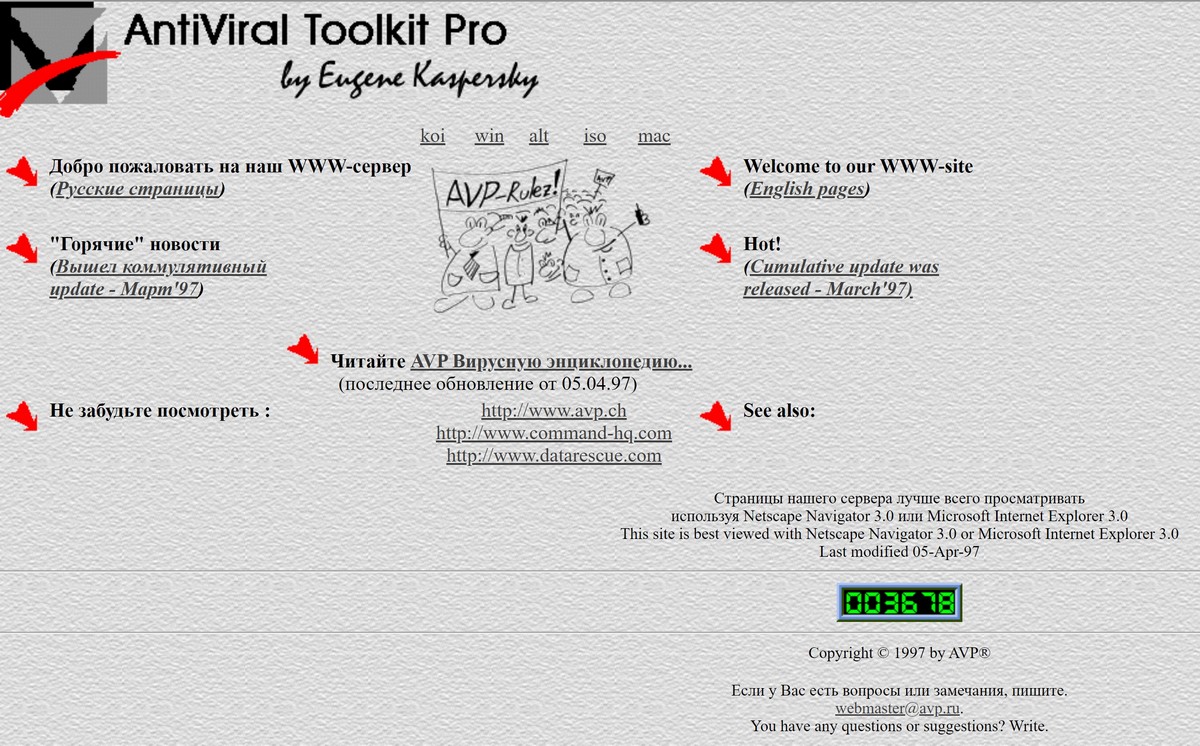June 29, 2020
Cyber-yesteryear – pt. 5: 1996 (game-changer year).
Herewith, more tales from back in the day about how our company went from humble beginnings to what we are today. And this cyber-yesteryear series – it’s all thanks to… lockdown! I’d have never found the time for such meanderings down cyber-memory lane otherwise…
Just in case you missed them, here are the previous installments:
All righty. Part 5: 1996. Truly a fateful, watershed year…
First, at KAMI, where I was still working, the owners decided to break away. As a result KAMI was split up into several independent organizations. And in the following year – 1997 – we broke away too.
Second, we signed an OEM (original equipment manufacturer) contract with the German company G-Data to supply them with of our antivirus engine. That contract ran for a full 12 years – up to 2008! – when we became No.1 on the German retail market. That’s just how it went. Our original-tech prowess was unstoppable! But what were we to do? But, anyway, it was G-Data who’d approached us (we weren’t able to actively seek out tech-partners back then), offering Remizov – boss of KAMI – cooperation, culminating in the signing of the contract at CeBIT, as described in Part 4. And that was how our technology-licensing business took off.
After the Germans (in 1995) came the Finns – F-Secure (in 1996), then known as Data Fellows. Let me tell you about how our cooperation with them started.
In August 1995, the first ever macro virus appeared, which infected Microsoft Word documents. It turned out that writing macro viruses was very straightforward, and they were being spread at alarming rates among a great many unsuspecting users. This caught the attention of other virus writers, and very quickly macro viruses became the biggest headache for the antivirus industry. Detecting them was far from easy, since the format of a Word document is most complex (who knew?:). So for several months AV firms played shamen using various methods, until when, in early 1996, McAfee (the company:) announced the ‘correct’ disassembly method for the format of Word documents. That news was latched onto by our colleague Andrey Krukov (who’d joined our collective in 1995), and he quickly came up with a most elegant and effective tech solution. I put the word out about this, and pretty soon companies started approaching us with offers to buy our technology. Having garnered several such offers, we arranged a meet with them all – at the upcoming Virus Bulletin Conference in Brighton, UK, where Andrey and I traveled to in the fall of 1996.

In Brighton, things hardly went to plan: none of those meetings ever came to anything! However…
We had a very interesting chat with Command Software – I recall in a very swish presidential suite of a hotel they’d booked for meetings. This company had long been licensing the AV engine of the company F-Prot. But for several years already the F-Prot developers hadn’t been able to come up with a new engine, and their partners were most unhappy and looking out for alternatives (a bit like Apple unhappy with Intel; but I digress).
Now, the good folks at Command Software invited Andrey and me over to the U.S. for us to start working for them – I recall with all sorts of juicy enticements, like houses, cars and fat salaries! We turned them down, saying we’d think about it, but that we weren’t planning on leaving Moscow any time soon. And that was that. Of course, being offered so much good stuff over in the States was very flattering, so as we left the fancy hotel room and were walking through the lobby we were smiling like Cheshire cats who’d got the cream! And it was in that lobby where the fellows from Data Fellows noticed our grins. We stopped for a chat. And to cut a long story short – two months later Natalya Kaspersky traveled north to Helsinki to discuss terms and conditions of cooperation and we soon signed with them a contract. Well, well. What a ricochet!
The contract with Data Fellows was… pure technological slavery! It denied us, among other things, the right to develop internet solutions and management systems for enterprise solutions, and what’s more, the contract was exclusive, meaning we didn’t have the right to license out our engine to anyone besides Data Fellows (and G-Data, due to the ongoing contract with it). Wait – there’s more. The Finns had all the rights to our technologies and the source code! Indeed, the contract was oppressive. However, we had no other choice. For without the money we’d make on it we simply wouldn’t have survived. So we signed it. And just as well, for Data Fellows provided us with our core source of income for the next several years. We’d live from paycheck to paycheck – actually, from payment from the Finns to payment from the Finns. However, as time passed, one by one the severe limitations were lifted; first: the prohibition of our developing products; then – the exclusivity. Only in the summer of 2006 did we finally break free of all of our chains completely – nearly 10 years after we’d signed it.
Third, (returning to the list of landmark events of 1996), we finally began developing a product for Windows 95. This should have been started two years earlier, but [cough] all our developers were tied up on other things! Alexey ‘the Count’ De Mont De Rique was busy with the solution for MS-DOS. Andrey Tikhonov was busy working on the solution for Novell NetWare, and Larissa Gruzdeva was still on with a version for Windows 3.xx. There was simply physically no one to work on development of a product for the most promising OS in the world! Looking back with the benefit of hindsight, that was just bonkers…
Once development of a Windows version got underway, we get to fourth…
At Moscow’s Comtek exhibition in the fall of 1996, I approached the stand of what was then the monopoly antivirus firm in Russia – a company called Dialog Science – and asked them about their latest products. I was looked up and down, and from their fancy stand (for the times) I was informed how old MS-DOS programs work fine on Windows. To which I replied: ~”I’m going to eat you all up!” They merely smiled, probably thinking, ‘yeah, right’ ).
And most importantly, fifth…
We started – and completed – development of a new antivirus engine (AVP3), which would serve – with hardly any changes – for a full decade in millions of copies of our products around the world, and also in the products of our technological partners. Only in the spring of 2008 did we start to replace it with our new engine (KLAVA) – at first in our home products, and later, in early 2009, in our main corporate products.
The main innovation of the new technology in AVP3 was its being multi-platform; that is, one and the same engine with the same databases worked on any Intel-based platform. Hitherto it was an engine per-platform: each needed its own, which had to be ported; but – worse – each database needed to be ported too (since they contained executable code). Our new engine cut out all the duplication. Game-changer.
Moreover, the engine had its own module (in part, for licensing to tech partners). As a result we had a universal, multi-platform engine and universal, multi-platform databases. You could use them to make your own antivirus (which companies did). It represented a jolt not only toward further development of the OEM business of the company, but also to the development of own products, since the main components (engine + databases) were maximally ‘tuned’ for being embedded in different products for different platforms; i.e., DOS16/32, Windows, Novell, Linux, OS/2, Unix and others.
Sixth…
Even more important was the launch of our products for Window 95. Exactly when the official ‘launch’ took place is difficult to pin down: there were plenty of public beta versions between fall 1996 and summer 1997 – were they ‘products’? Probably they became full fledged (non-beta) versions only in the early 2000s. The first ever beta-prototype was presented to the public on September 16, 1996, and it was called AVP for Win95 3.0, build 105. And based on the source code of that was compiled a DOS version, so, probably, it was September 1996 was when 3.0 was launched.
And finally, seventh!…
In November 1996 we finally launched our website, one of the versions of which you can find here, and the archive of the site – here. We wrote the texts ourselves, and drew the pictures ourselves too (most of the illustrations being my handiwork:).

To be continued!…

